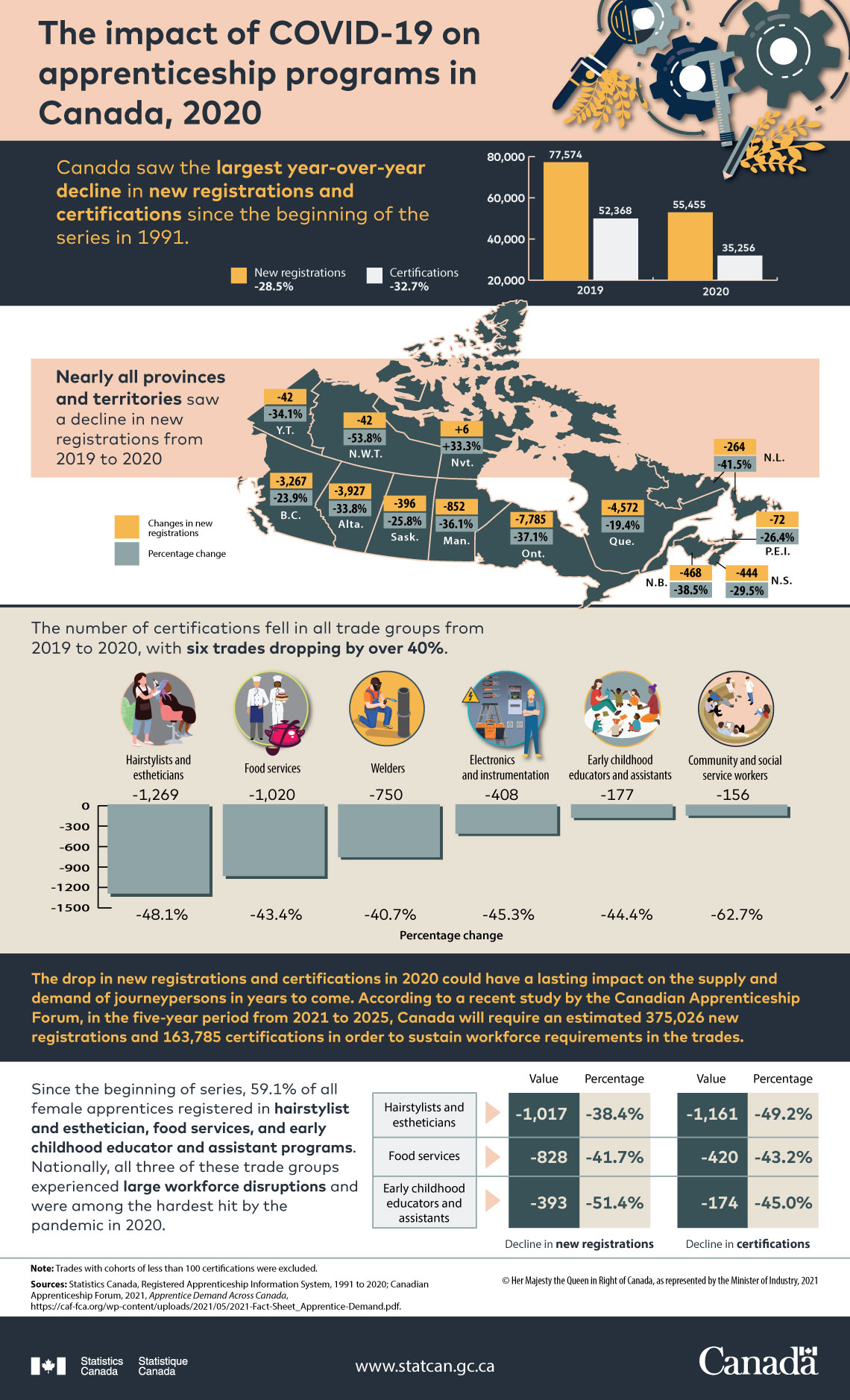The impact of COVID-19 on apprenticeship programs in Canada, 2020
Archived Content
Information identified as archived is provided for reference, research or recordkeeping purposes. It is not subject to the Government of Canada Web Standards and has not been altered or updated since it was archived. Please "contact us" to request a format other than those available.

Description: The impact of COVID-19 on apprenticeship programs in Canada, 2020
Canada saw the largest year-over-year decline in new registrations and certifications since the beginning of the series in 1991.
| Totals - Canada | 2019 | 2020 | Difference |
|---|---|---|---|
| New registrations | 77,574 | 55,455 | -22,119 (-28.5%) |
| Certifications | 52,368 | 35,256 | -17,112 (-32.7%) |
Nearly all provinces and territories saw a decline in new registrations from 2019 to 2020.
| Jurisdiction | Change in new registrations | Percentage change |
|---|---|---|
| Ontario | -7,785 | -37.1% |
| Quebec | -4,572 | -19.4% |
| Alberta | -3,927 | -33.8% |
| British Columbia | -3,267 | -23.9% |
| Manitoba | -852 | -36.1% |
| New Brunswick | -468 | -38.5% |
| Nova Scotia | -444 | -29.5% |
| Saskatchewan | -396 | -25.8% |
| Newfoundland and Labrador | -264 | -41.5% |
| Prince Edward Island | -72 | -26.4% |
| Yukon | -42 | -34.1% |
| Northwest Territories | -42 | -53.8% |
| Nunavut | 6 | 33.3% |
The number of certifications fell in all trade groups from 2019 to 2020, with six trades dropping by over 40%
| Trade | Decline in certifications | Percentage change |
|---|---|---|
| Community and social service workers | -156 | -62.7% |
| Hairstylists and estheticians | -1,269 | -48.1% |
| Electronics and instrumentation | -408 | -45.3% |
| Early childhood educators and assistants | -177 | -44.4% |
| Food services | -1,020 | -43.4% |
| Welders | -750 | -40.7% |
The drop in new registrations and certifications in 2020 could have a lasting impact on the supply and demand of journeypersons in years to come. According to a recent study by the Canadian Apprenticeship Forum, in the five-year period from 2021 to 2025, Canada will require an estimated 375,026 new registrations and 163,785 certifications in order to sustain workforce requirements in the trades.
Since the beginning of series, 59.1% of all female apprentices registered in hairstylist and esthetician, food services, and early childhood educator and assistant programs. Nationally, all three of these trade groups experienced large workforce disruptions and were among the hardest hit by the pandemic in 2020.
| Trades | Decline in new registrations | Decline in certifications | ||
|---|---|---|---|---|
| Value | Percentage | Value | Percentage | |
| Hairstylists and estheticians | -1,017 | -38.4% | -1,161 | -49.2% |
| Food services | -828 | -41.7% | -420 | -43.2% |
| Early childhood educators and assistants | -393 | -51.4% | -174 | -45.0% |
Note: Trades with cohorts of less than 100 certifications were excluded.
Sources: Statistics Canada, Registered Apprenticeship Information System, 1991 to 2020; Canadian Apprenticeship Forum, 2021, Apprentice Demand Across Canada, https://caf-fca.org/wp-content/uploads/2021/05/2021-Fact-Sheet_Apprentice-Demand.pdf.
- Date modified:
